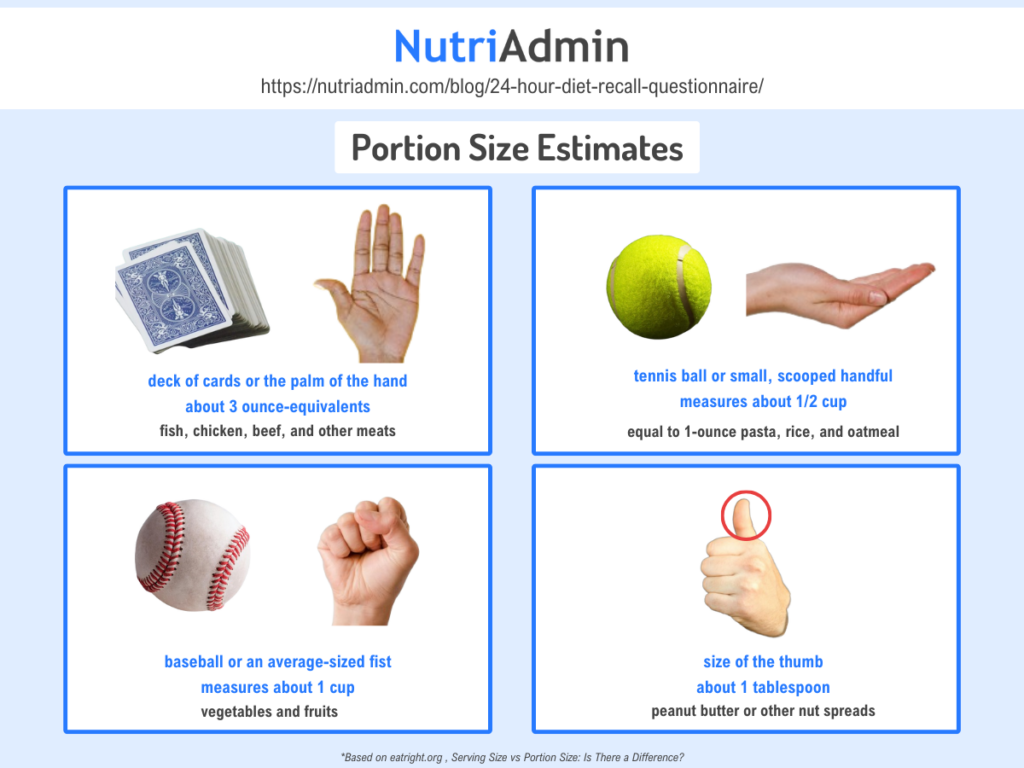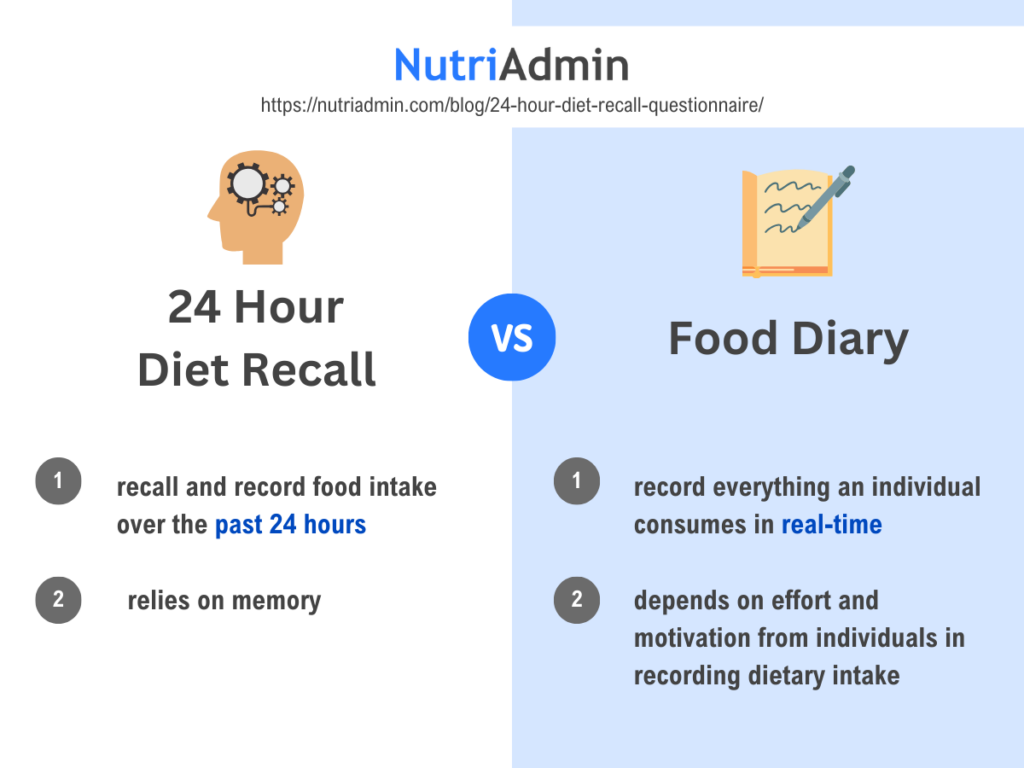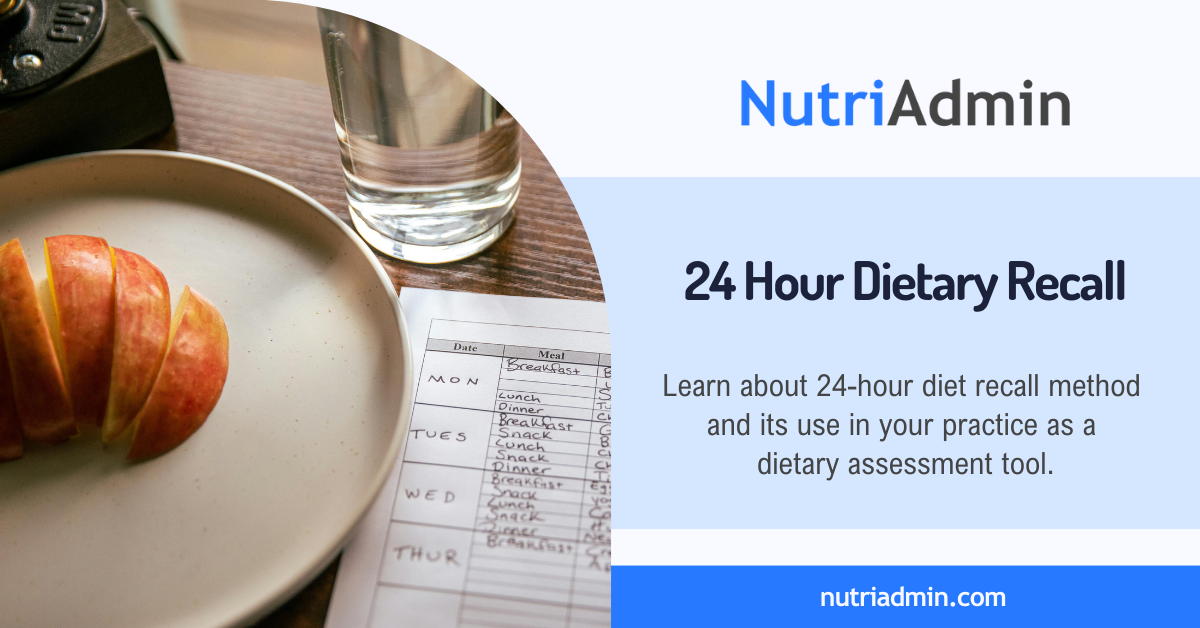Do you want to use 24-hour diet recall as a nutritional assessment tool but are unsure how? In this article, we’ll discuss the 24-hour diet recall method, how reliable this food recall questionnaire is, practical tips on using it effectively, and alternatives like a food diary. If you stay until the end, you can download a 24-hour diet recall form template that you can use in your practice.
What is a 24-hour Diet Recall Method?
The 24-hour dietary recall method is a valuable tool for nutritional assessment in both research and clinical settings. It obtains detailed information on an individual’s dietary intake over a 24-hour period.

The method involves asking individuals to recall all the foods and beverages they consumed over the past 24 hours. It includes not just the type of food and beverages but also its portion sizes, cooking methods, time of consumption, and brand names.
To estimate usual dietary intake distributions accurately, it is best to conduct two or more non-consecutive 24-hour diet recalls, usually on two weekdays and one weekend. This approach is recommended, especially when analyzing diet and health or other related factors.
What is the Purpose of the 24-hour Food Recall Questionnaire?
It aims to provide a comprehensive dietary assessment that can be used to identify dietary patterns and assess nutrient intake. Consequently, this can help the practitioner formulate a nutrition diagnosis and provide the client with an appropriate dietary recommendation.
How Reliable is the 24-hour Dietary Recall?
The 24-hour dietary recall method is generally considered reliable. However, it is subject to recall bias, which affects its accuracy in reflecting an individual’s usual dietary intake. This means that the accuracy will depend on the client’s memory of what and how much food they consumed within the 24-hour period.
There are several ways to reduce bias. It is important to ask specific questions and use visual aids like food models or infographics. Providing prompts to help individuals remember what they consumed can also help.
Improving 24-Hour Diet Recall Accuracy: Practical Tips
The USDA uses the multi-pass method to address the recall bias. Dietary data is gathered using five steps. The initial stage is an unstructured, continuous list of all the foods and drinks ingested. The three following phases employ memory cues and an organized method of gathering data. There are also additional memory triggers in the Final Probe stage, which is an unstructured question for any other meals recalled.
Alternatively, you can use the following simple tips to help improve the accuracy of your 24-hour dietary recall.
Provide a food portion visual aid
Use measuring cups, spoons, or food models to help clients accurately estimate portion sizes. If you’re using a self-administered or online questionnaire tool, you can add infographics or images to help clients visualize portion sizes. This can significantly improve the accuracy of reported quantities.

Prompt question examples during 24-hour food recall interview:
- How many spoons of peanut butter did you add to your toast?
- Did you eat the whole apple or just half?
Ask about food preparation methods
Ask about how foods were prepared (e.g., fried, baked, grilled) and any added ingredients (e.g., butter, oil, sauces), as these can affect nutrient content.
Prompt question examples:
- Was the chicken deep-fried or air-fried?
- What dressing did you add to your salad? How many tablespoons did you add?
Encourage detailed descriptions
Ask clients to provide detailed descriptions of the foods and beverages consumed, including brand names, flavors, and any toppings or condiments used.
Prompt question examples:
- What type of bread did you eat? Was it whole wheat or plain white bread? What brand was it?
- Did you add any sugar or milk to your coffee? Is it whole milk, low-fat, or skimmed?
- What types of fruits did you add to your smoothie? What brand of protein powder do you add?
Inquire about snacks and beverages
People often forget to report snacks, beverages (including water), and small bites throughout the day. Ask questions related to this to help clients recall these if they ate snacks and drinks.
Prompt question examples:
- Did you eat or drink anything before lunch? Any snacks? Coffee or tea?
- Do you drink milk before you sleep?
Conduct the recall as soon as possible
Try to ask the client to complete the dietary recall as soon as possible. It’s important to capture details while they’re fresh in their memory to get the most accurate data and minimize the recall bias.
Break down the day
Ask clients to recall their intake by breaking down the day into smaller segments (e.g., morning, afternoon, evening) to make it easier to remember.
Use prompt questions about eating locations
Ask about where the food was consumed (e.g., home, restaurant, work). This can help trigger memories of specific meals or snacks.
Sample prompt questions:
- Where did you have lunch? Do you pack your lunch or eat out?
- Did you eat breakfast at home?
Be patient and non-judgmental
Create a comfortable environment for clients to recall their intake accurately without feeling judged or pressured. Make sure to explain the purpose why you are conducting the food recall. Explain how their honesty in reporting their intake can help you make more effective nutrition plans for them.
24-Hour Dietary Recall Alternatives and Differences
Different methods are used for dietary assessment. These include a food diary, food frequency questionnaire, food checklists, and diet history. Additionally, as technology advances, nutrition software or apps incorporate these traditional methods to make them more accessible to clients.
Food Frequency Questionnaires
Food Frequency Questionnaires assess the frequency and portion size of foods and beverages consumed over a defined period, usually from weeks to months.
It includes a list of foods and beverages as well as dietary supplements with response options indicating how often each item is consumed, such as daily, weekly, monthly, or rarely. The list can range from 80 to 120 items. Nutritional research, epidemiological studies, and clinical practice commonly use FFQs as a long-term dietary assessment method.
Diet History
The diet history consists of a combination of short and long-term methods, typically 24-hour recall, FFQ, or food diary. Experienced dietitians often use it in clinical settings to conduct thorough assessments at an individual level.
Food Diary
Food diaries and 24-hour diet recalls may confuse many individuals because both assessment methods involve listing a person’s food intake.
The food diary or log is an alternative to the 24-hour food recall method. It requires individuals to record all the foods and beverages they consume over a period of time. This is usually within several days or a week.

The food diary method provides a more comprehensive picture of an individual’s dietary habits. It is also less subject to recall bias. Additionally, it can help identify potential areas for improvement and provide feedback on specific dietary behaviors.
However, the food diary method requires more effort and motivation from individuals to record their dietary intake accurately. Individuals may underreport foods they perceive as unhealthy or overreport foods they perceive as healthy.
Using Online Tools: 24 hour Diet Recall Form
In the past, 24-hour diet recall could only be conducted through an in-person or phone interview. Now, due to technology, some dietary assessment methods, like the food recall, can be turned into a form or questionnaire that clients can self-administer.
There are several ways to make a 24-hour diet recall template for free. You can use tools like Microsoft Word, Google Forms, or other similar platforms. Alternatively, you can use professional nutrition software with a questionnaire feature like NutriAdmin.
These professional nutrition apps allow you to create other nutrition questionnaires, such as nutritional assessment forms and food preference questionnaires.
24-Hour Diet Recall Template in NutriAdmin
You can download the free PDF generated through NutriAdmin below of a 24-hour diet recall form template. Alternatively, you can use it as the food recall form template and copy its contents to your chosen questionnaire platform.
In NutriAdmin, you can share questionnaires like the 24 diet recall with clients through the client portal, via email, or through your website as a web widget. You may also share the questionnaires as links through emails and other communication apps so your client can access them easily and conveniently.
Click the button below to try the online questionnaire feature in NutriAdmin. You will consent to receiving marketing communications from us when you share your email address. You’re free to opt-out at any time. The data you provide is only for demonstration purposes and will be deleted after.




